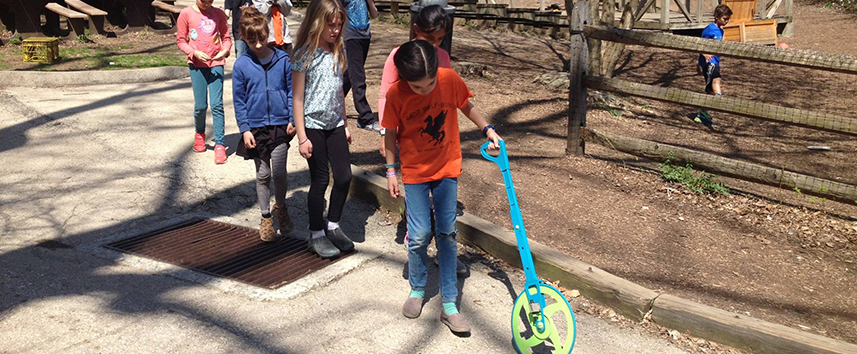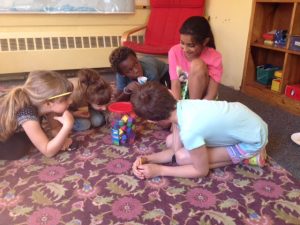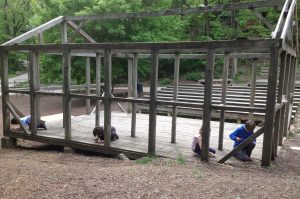Giving voice to our best guess

On a recent afternoon, our math half group gathered in a circle around the rug with a container of small colorful cubes. Each child had a notecard and a pencil, and the question was simple: “How many cubes do you think are in the jar?” Our guesses were jotted down and then laid out along a number line in the center of the circle.
 As each of us named a number, we also gave our reasoning or method for arriving at that estimate. KB said he approximated how many cubes looked to be in each layer and then counted up how many layers seemed to lie inside the clear container. PT counted up ten cubes on the outside of the jar and estimated how many sets of ten might be inside. NH noticed that the jar said “100 cubes” on the label, but over time and use was now only about two-thirds full, and so based her guess on that.
As each of us named a number, we also gave our reasoning or method for arriving at that estimate. KB said he approximated how many cubes looked to be in each layer and then counted up how many layers seemed to lie inside the clear container. PT counted up ten cubes on the outside of the jar and estimated how many sets of ten might be inside. NH noticed that the jar said “100 cubes” on the label, but over time and use was now only about two-thirds full, and so based her guess on that.
We saw most of the numbers clustered around the 60’s and 70’s, and talked about vocabulary we had learned earlier in the year, like the range of the data and the median value. There was one outlier in the set, a guess in the 20’s, and that child considered whether she wanted to alter her estimate based on the data set and some of the friends’ reasoning. In the next stage the children began to count out the cubes in sets of 10, and once we reached 30 cubes, I invited them to reconsider their initial estimation now that we had made it through about half of the cubes.
The conversation about strategies for estimation here was much more interesting than a focus on getting an answer “right.” This kind of math talk offers children a different kind of mental exercise than other math lessons. It helps to develop stronger number sense, or internal understanding of the relationship between number values. It also introduces the idea of reasonableness in estimation. Each child in such a conversation also has an equal and valued voice in the discussion. We hope in our math talks to emphasize the process of inquiry over the speedy search for a single right answer.
We extended this process another day in a measurement lesson outdoors. The group has been working recently with benchmark distances, and in this case we worked with the length of 10 feet as a way to help us estimate other lengths or distances around campus. Pairs of children measured out a 10 foot long  piece of string, and used it to work on questions like “What is the perimeter of the play barn?” or “Starting from the box elder tree, if you travel 50 feet, where do you think you would end up?” Each student recorded his or her estimate before measuring or answering.
piece of string, and used it to work on questions like “What is the perimeter of the play barn?” or “Starting from the box elder tree, if you travel 50 feet, where do you think you would end up?” Each student recorded his or her estimate before measuring or answering.
We noticed in  this activity that the children drew on so much prior knowledge and strategies of earlier work we had done. They thought about measurement in a different way when comparing lengths and distances only with a 10 foot string as a tool and not using our yardsticks or meter sticks as we have other times. Some children noticed you could fold the string in half to assess a five foot span, others that it was harder to guess longer distances accurately than shorter ones. TL said, “I couldn’t believe the top of the play structure is shorter than ten feet tall — when I was littler it always seemed gigantic to me!” Sara and I loved listening in on the though
this activity that the children drew on so much prior knowledge and strategies of earlier work we had done. They thought about measurement in a different way when comparing lengths and distances only with a 10 foot string as a tool and not using our yardsticks or meter sticks as we have other times. Some children noticed you could fold the string in half to assess a five foot span, others that it was harder to guess longer distances accurately than shorter ones. TL said, “I couldn’t believe the top of the play structure is shorter than ten feet tall — when I was littler it always seemed gigantic to me!” Sara and I loved listening in on the though tful conversations, and sometimes disagreements, among the partners as they worked.
tful conversations, and sometimes disagreements, among the partners as they worked.
Our math work at Miquon feels like it is at its best when the children are engaged in making meaning on their own terms. Oftentimes they are working across several “topics,” such as connecting mathematical reasoning skills with their number sense and experience of relative distances. Activities which include estimation are especially valuable in emphasizing the importance of the reasoning process. Rich discussions in which various children can justify their guesses to one another open up ways to develop a strong math vocabulary and confidence in one’s voice.